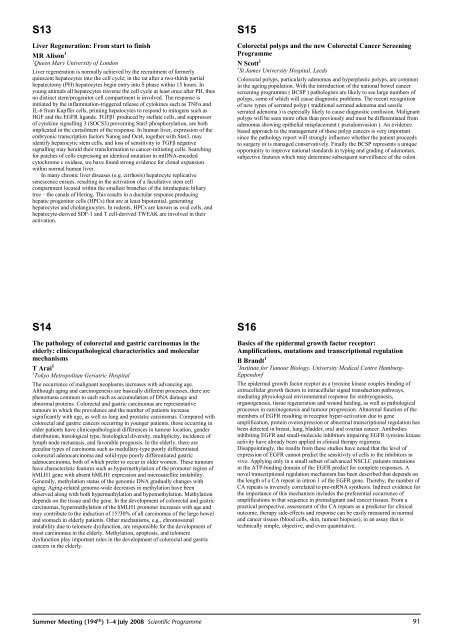2008 Summer Meeting - Leeds - The Pathological Society of Great ...
2008 Summer Meeting - Leeds - The Pathological Society of Great ...
2008 Summer Meeting - Leeds - The Pathological Society of Great ...
Create successful ePaper yourself
Turn your PDF publications into a flip-book with our unique Google optimized e-Paper software.
S13Liver Regeneration: From start to finishMR Alison 11 Queen Mary University <strong>of</strong> LondonLiver regeneration is normally achieved by the recruitment <strong>of</strong> formerlyquiescent hepatocytes into the cell cycle; in the rat after a two-thirds partialhepatectomy (PH) hepatocytes begin entry into S phase within 15 hours. Inyoung animals all hepatocytes traverse the cell cycle at least once after PH, thusno distinct stem/progenitor cell compartment is involved. <strong>The</strong> response isinitiated by the inflammation-triggered release <strong>of</strong> cytokines such as TNF andIL-6 from Kupffer cells, priming hepatocytes to respond to mitogens such asHGF and the EGFR ligands. TGF1 produced by stellate cells, and suppressor<strong>of</strong> cytokine signalling 3 (SOCS3) preventing Stat3 phosphorylation, are bothimplicated in the curtailment <strong>of</strong> the response. In human liver, expression <strong>of</strong> theembryonic transcription factors Nanog and Oct4, together with Stat3, mayidentify hepatocytic stem cells, and loss <strong>of</strong> sensitivity to TGF negativesignalling may herald their transformation to cancer-initiating cells. Searchingfor patches <strong>of</strong> cells expressing an identical mutation in mtDNA-encodedcytochrome c oxidase, we have found strong evidence for clonal expansionwithin normal human liver.In many chronic liver diseases (e.g. cirrhosis) hepatocyte replicativesenescence ensues, resulting in the activation <strong>of</strong> a facultative stem cellcompartment located within the smallest branches <strong>of</strong> the intrahepatic biliarytree – the canals <strong>of</strong> Hering. This results in a ductular response producinghepatic progenitor cells (HPCs) that are at least bipotential, generatinghepatocytes and cholangiocytes. In rodents, HPCs are known as oval cells, andhepatocyte-derived SDF-1 and T cell-derived TWEAK are involved in theiractivation.S15Colorectal polyps and the new Colorectal Cancer ScreeningProgrammeNScott 11 St James University Hospital, <strong>Leeds</strong>Colorectal polyps, particularly adenomas and hyperplastic polyps, are commonin the ageing population. With the introduction <strong>of</strong> the national bowel cancerscreening programme ( BCSP ) pathologists are likely to see large numbers <strong>of</strong>polyps, some <strong>of</strong> which will cause diagnostic problems. <strong>The</strong> recent recognition<strong>of</strong> new types <strong>of</strong> serrated polyp ( traditional serrated adenoma and sessileserrated adenoma ) is especially likely to cause diagnostic confusion. Malignantpolyps will be seen more <strong>of</strong>ten than previously and must be differentiated fromadenomas showing epithelial misplacement ( pseudoinvasion ). An evidencebased approach to the management <strong>of</strong> these polyp cancers is very importantsince the pathology report will strongly influence whether the patient proceedsto surgery or is managed conservatively. Finally the BCSP represents a uniqueopportunity to improve national standards in typing and grading <strong>of</strong> adenomas,subjective features which may determine subsequent surveillance <strong>of</strong> the colon.S14<strong>The</strong> pathology <strong>of</strong> colorectal and gastric carcinomas in theelderly: clinicopathological characteristics and molecularmechanismsTArai 11 Tokyo Metropolitan Geriatric Hospital<strong>The</strong> occurrence <strong>of</strong> malignant neoplasms increases with advancing age.Although aging and carcinogenesis are basically different processes, there arephenomena common to each such as accumulation <strong>of</strong> DNA damage andabnormal proteins. Colorectal and gastric carcinomas are representativetumours in which the prevalence and the number <strong>of</strong> patients increasesignificantly with age, as well as lung and prostatic carcinomas. Compared withcolorectal and gastric cancers occurring in younger patients, those occurring inolder patients have clinicopathological differences in tumour location, genderdistribution, histological type, histological diversity, multiplicity, incidence <strong>of</strong>lymph node metastasis, and favorable prognosis. In the elderly, there arepeculiar types <strong>of</strong> carcinoma such as medullary-type poorly differentiatedcolorectal adenocarcinoma and solid-type poorly differentiated gastricadenocarcinoma, both <strong>of</strong> which prefer to occur in older women. <strong>The</strong>se tumourshave characteristic features such as hypermethylation <strong>of</strong> the promoter region <strong>of</strong>hMLH1 gene with absent hMLH1 expression and microsatellite instability.Generally, methylation status <strong>of</strong> the genomic DNA gradually changes withaging. Aging-related genome-wide decreases in methylation have beenobserved along with both hypermethylation and hypomethylation. Methylationdepends on the tissue and the gene. In the development <strong>of</strong> colorectal and gastriccarcinomas, hypermethylation <strong>of</strong> the hMLH1 promoter increases with age andmay contribute to the induction <strong>of</strong> 15?30% <strong>of</strong> all carcinomas <strong>of</strong> the large boweland stomach in elderly patients. Other mechanisms, e.g., chromosomalinstability due to telomere dysfunction, are responsible for the development <strong>of</strong>most carcinomas in the elderly. Methylation, apoptosis, and telomeredysfunction play important roles in the development <strong>of</strong> colorectal and gastriccancers in the elderly.S16Basics <strong>of</strong> the epidermal growth factor receptor:Amplifications, mutations and transcriptional regulationB Brandt 11 Institute for Tumour Biology, University Medical Centre Hamburg-Eppendorf<strong>The</strong> epidermal growth factor recptor as a tyrosine kinase couples binding <strong>of</strong>extracellular growth factors to intracellular signal transduction pathways,mediating physiological environmental response for embryogenesis,organogenesis, tissue regeneration and wound healing, as well as pathologicalprocesses in carcinogenesis and tumour progression. Abnormal function <strong>of</strong> themembers <strong>of</strong> EGFR resulting in receptor hyper-activation due to geneamplification, protein overexpression or abnormal transcriptional regulation hasbeen detected in breast, lung, bladder, oral and ovarian cancer. Antibodiesinhibiting EGFR and small-molecule inhibitors impairing EGFR tyrosine kinaseactivity have already been applied in clinical therapy regimens.Disappointingly, the results from these studies have noted that the level <strong>of</strong>expression <strong>of</strong> EGFR cannot predict the sensitivity <strong>of</strong> cells to the inhibitors invivo. Applying only in a small subset <strong>of</strong> advanced NSCLC patients mutationsin the ATP-binding domain <strong>of</strong> the EGFR predict for complete responses. Anovel transcriptional regulation mechanism has been described that depends onthe length <strong>of</strong> a CA repeat in intron 1 <strong>of</strong> the EGFR gene. <strong>The</strong>reby, the number <strong>of</strong>CA repeats is inversely correlated to pre-mRNA synthesis. Indirect evidence forthe importance <strong>of</strong> this mechanism includes the preferential occurrence <strong>of</strong>amplifications in that sequence in premalignant and cancer tissues. From apractical perspective, assessment <strong>of</strong> the CA repeats as a predictor for clinicaloutcome, therapy side-effects and response can be easily measured in normaland cancer tissues (blood cells, skin, tumour biopsies), in an assay that istechnically simple, objective, and even quantitative.<strong>Summer</strong> <strong>Meeting</strong> (194 th ) 1–4 July <strong>2008</strong> Scientific Programme91













